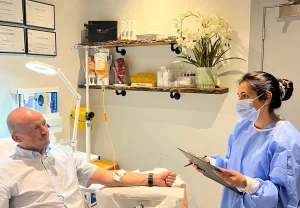
Working as a phlebotomist can be incredibly rewarding, but let’s face it—sometimes it can feel like you’re on the front lines of a medical battlefield. Between the needle-phobes, the “I faint at the sight of blood” crowd, and the impatient “I have a meeting in 10 minutes” folks, every day is an adventure. But fear not! With the right strategies and a dash of humor, you can handle even the most difficult patients like a pro. Let’s dive into some practical advice on managing challenging patient interactions, complete with examples, research, and a few laughs along the way.
The Art of Calming Anxious Patients
1. The “I Hate Needles” Patient
Example: Meet John. John is a grown man with a tattoo sleeve, but the moment he sees a needle, he turns into a quivering puddle of fear.
Strategy: Empathy and distraction are your best friends here. Start by acknowledging their fear. “I know needles aren’t anyone’s favorite thing, but I promise to be quick and gentle.” Then, engage them in a distraction. “So, tell me about your tattoos. Which one’s your favorite?”
Research Insight: According to a study published in the Journal of Anxiety Disorders, distraction techniques significantly reduce perceived pain and anxiety during medical procedures.
Professionalism in the Face of Impatience
2. The “I’m in a Rush” Patient
Example: Say hello to Karen. Karen has an important meeting in 10 minutes and thinks that her urgency somehow bends the laws of time and space.
Strategy: Efficiency coupled with clear communication is key. “I understand you’re in a hurry, and I’ll do my best to get you out quickly. Just need to make sure we do this right.” Use a calm, assertive tone to manage expectations without compromising quality.
Research Insight: The British Journal of Nursing highlights that clear communication and time management can enhance patient cooperation and satisfaction, even in rushed scenarios.
Handling the Unexpected
3. The Fainter
Example: Meet Sam. Sam swears he’s fine, but five seconds into the blood draw, and he’s out like a light.
Strategy: Prevention is better than cure. Ask patients if they have a history of fainting. If they do, have them lie down during the procedure. If fainting occurs, follow your training protocols—elevate their legs and ensure they regain consciousness safely.
Research Insight: The Journal of Clinical Pathology suggests that pre-emptively asking about fainting tendencies and preparing accordingly can reduce incidents and improve patient safety.
Tips for Professional Handling of Difficult Situations
1. Stay Calm and Confident
No matter how difficult a patient might be, your calm demeanor will set the tone for the interaction. Patients often mirror the behavior of healthcare professionals, so maintaining your composure can help de-escalate tense situations.
2. Use Humor Wisely
A little humor can go a long way in easing patient anxiety and building rapport. Just make sure it’s appropriate for the situation. “You know, if I had a dollar for every time someone said they hate needles, I’d be on a beach somewhere right now.”
3. Educate and Inform
Sometimes, patients are difficult because they don’t understand the process. Take a moment to explain what you’re doing and why. Knowledge can often ease fears. “This tube might look scary, but it’s actually designed to make the blood draw quicker and less painful.”
Phlebotomy Training and Courses: The Foundation of Patient Management
Handling difficult patients isn’t just about innate skill; it’s also about solid training. Quality phlebotomy courses cover patient interaction techniques, safety protocols, and emergency procedures.
Phlebotomy Training Courses:
- Certified Phlebotomy Technician (CPT): This course covers everything from blood collection techniques to patient interaction skills. A must for any aspiring phlebotomist.
- Advanced Phlebotomy Training: For those looking to hone their skills further, advanced courses offer deeper insights into handling complex cases and difficult patients.
- Patient Communication Workshops: Often included in phlebotomy training programs, these workshops focus on building rapport and managing patient anxiety.
- Phlebotomy Proteges Pathway: This training is organized by www. omnihealthhub.com and it’s a comprehensive course that leads you to mastery.
Dealing with difficult patients is part and parcel of being a phlebotomist, but with the right approach, you can turn these challenges into opportunities for building trust and providing excellent care. Remember, every anxious John, rushed Karen, and fainting Sam is a chance to showcase your professionalism, empathy, and skill.
For those considering a career in phlebotomy, or looking to upgrade their skills, investing in comprehensive phlebotomy training courses can equip you with the tools you need to handle any patient situation with grace and confidence.
Keep drawing those blood samples, one patient at a time, and remember—every difficult interaction is just another step in your journey to becoming an exceptional phlebotomist.
References
- Journal of Anxiety Disorders. (2022). Distraction Techniques in Medical Procedures.
- British Journal of Nursing. (2021). The Role of Communication in Patient Cooperation.
- Journal of Clinical Pathology. (2023). Managing Fainting Incidents in Phlebotomy.
- National Phlebotomy Association. (2023). Phlebotomy Certification and Training Programs
Yours Sincerely
Blood Baron
Olukunmi Nuels
